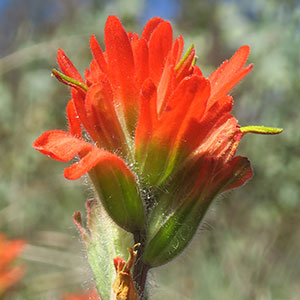Castilleja brevilobata
Castilleja salsuginosa
short-lobed paintbrush
Monte Neva Indian paintbrush, Monte Neva paintbrush
solitary or few, erect or ascending, unbranched, sometimes branched, hairs spreading, short, medium, and long, soft, short and medium ones short stipitate-glandular.
several, erect, usually decumbent at base, unbranched, sometimes branched, sometimes with short, leafy axillary shoots, hairs spreading, short, rather stiff, some glandular.
green or ± yellow, lanceolate, elliptic, or oblong to narrowly ovate, 1–2(–2.5) cm, not fleshy, margins plane or wavy, involute, (0–)3–5(–7)-lobed, apex rounded to acute;
lobes ascending to erect, linear to lanceolate, apex rounded to acute.
purplish brown with a grayish cast (due to adhering soil particles and salt crystals), linear to narrowly lanceolate, 1.5–2.5(–3) cm, fleshy, margins plane, sometimes wavy, involute, 0–3(–5)-lobed, apex acute;
lobes spreading, linear to narrowly lanceolate, apex obtuse.
3–20 × 2–3.5 cm;
bracts proximally greenish to dull brown, distally red, orange-red, or scarlet, sometimes orange or yellow, broadly lanceolate or oblong, (0–)3–5-lobed;
lobes ascending, broadly to narrowly lanceolate, short, arising above mid length, apex acute, obtuse, or rounded.
3–10 × 1.5–5 cm;
bracts proximally purplish, deep burgundy, lavender, dull reddish, or deep purple, distally greenish, white, cream, or pink on margins and apices, oblong, 3(–5)-lobed;
lobes ascending, ± linear, medium length, arising above mid length, central lobe apex rounded to obtuse, expanded distally, lateral ones acute.
straight, 15–24(–26) mm;
tube 12–16 mm;
beak exserted, abaxial lip equal to calyx;
beak adaxially green or ± yellow-green, 7–10 mm, puberulent, stipitate-glandular;
abaxial lip deep green, reduced, rounded, 1–2 mm, 10–25% as long as beak;
teeth incurved to erect, light green, 0.5–1 mm.
straight or slightly curved, 18–22(–24) mm;
tube 13–18 mm;
beak, sometimes abaxial lip, exserted;
beak adaxially purplish brown, 4.5–6.5 mm, conspicuously exceeding abaxial lip, margins reddish or colored as bracts, apices white or cream;
abaxial lip reddish purple with green in a distal band or along grooves, gradually inflated, grooved, (2–)3–4(–4.5) mm, 67% as long as beak;
teeth erect to slightly spreading, white to cream, often with purple spot, 1.4–2(–2.5) mm.
green or whitish with green veins, lobes colored as bract lobes or paler, 14–30 mm;
abaxial and adaxial clefts 5.5–8.5 mm, 30–40% of calyx length, deeper than laterals, lateral 1.5–4 mm, 20–25% of calyx length;
lobes oblong to narrowly triangular, apex obtuse to rounded.
proximally whitish, distally purple to sometimes pink, margins white or cream, 16–20 mm;
abaxial and adaxial clefts 5–8.5 mm, 20–45% of calyx length, all 4 clefts subequal;
lobes linear or narrowly lanceolate, apex obtuse to rounded.
blackish.
= 24.
= 24.
Castilleja brevilobata
Castilleja salsuginosa
Castilleja brevilobata is endemic to dry serpentine openings in the Siskiyou Mountains of southwestern Oregon and adjacent California. Although sometimes treated as part of C. applegatei or C. hispida, its morphology does not suggest a close connection with either. This species occasionally hybridizes with C. pruinosa in Del Norte County, California.
(Discussion copyrighted by Flora of North America; reprinted with permission.)
Castilleja salsuginosa is endemic to a single site in White Pine County, where it is limited to the harsh alkaline soils of travertine hot springs. This population is threatened by habitat degradation from livestock, as well as by water developments affecting the hydrology of the hot spring system. Castilleja salsuginosa is closely related to C. nana and C. pilosa, but genetic studies of the trio are inconclusive so far. Two populations of very similar but slightly smaller-flowered plants occur around other hot springs in adjacent Eureka County. While they resemble C. salsuginosa superficially, recent morphometric studies of one of these populations indicate that they may be worthy of nomenclatural recognition, separate from C. salsuginosa.
Castilleja salsuginosa is in the Center for Plant Conservation’s National Collection of Endangered Plants.
(Discussion copyrighted by Flora of North America; reprinted with permission.)


